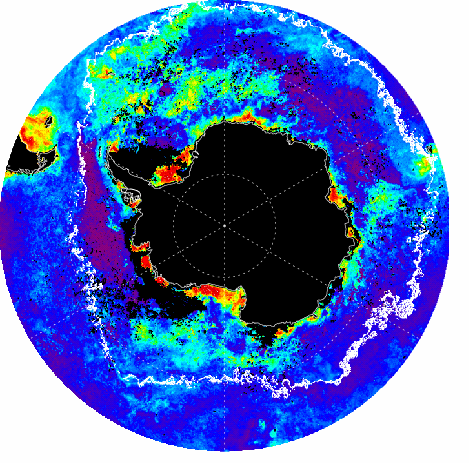 ©2020 Biological and Chemical Oceanography Data Management Office.
©2020 Biological and Chemical Oceanography Data Management Office.Funded by the U.S. National Science Foundation
NSF Proposal Title: Collaborative Research: Plankton Community Structure and Iron Distribution in the Southern Drake Passage and Scotia Sea
The Shackleton Fracture Zone (SFZ) in Drake Passage of the Southern Ocean defines a boundary between low and high phytoplankton waters. Low chlorophyll water flowing through the southern Drake Passage emerges as high chlorophyll water to the east, and recent evidence indicates that the Southern Antarctic Circumpolar Current Front (SACCF) is steered south of the SFZ onto the Antarctic Peninsula shelf where mixing between the water types occurs. The mixed water is then advected off-shelf with elevated iron and phytoplankton biomass. The SFZ is therefore an ideal natural laboratory to improve the understanding of plankton community responses to natural iron fertilization, and how these processes influence export of organic carbon to the ocean interior. The bathymetry of the region is hypothesized to influence mesoscale circulation and transport of iron, leading to the observed patterns in phytoplankton biomass. The position of the Antarctic Circumpolar Current (ACC) is further hypothesized to influence the magnitude of the flow of ACC water onto the peninsula shelf, mediating the amount of iron transported into the Scotia Sea. To address these hypotheses, a research cruise will be conducted near the SFZ and to the east in the southern Scotia Sea. A mesoscale station grid for vertical profiles, water sampling, and bottle incubation enrichment experiments will complement rapid surface surveys of chemical, plankton, and hydrographic properties. Distributions of manganese, aluminum and radium isotopes will be determined to trace iron sources and estimate mixing rates. Phytoplankton and bacterial physiological states (including responses to iron enrichment) and the structure of the plankton communities will be studied. The primary goal is to better understand how plankton productivity, community structure and export production in the Southern Ocean are affected by the coupling between bathymetry, mesoscale circulation, and distributions of limiting nutrients. The proposed work represents an interdisciplinary approach to address the fundamental physical, chemical and biological processes that contribute to the abrupt transition in chl-a which occurs near the SFZ. Given recent indications that the Southern Ocean is warming, it is important to advance the understanding of conditions that regulate the present ecosystem structure in order to predict the effects of climate variability. This project will promote training and learning across a broad spectrum of groups. Funds are included to support postdocs, graduate students, and undergraduates. In addition, this project will contribute to the development of content for the Polar Science Station website, which has been a resource since 2001 for instructors and students in adult education, home schooling, tribal schools, corrections education, family literacy programs, and the general public.
PUBLICATIONS PRODUCED AS A RESULT OF THIS RESEARCH
Hewes, C. D., Reiss, C.S., .Kahru, M. , Mitchell, B.G. , and Holm-Hansen, O.. "Control of phytoplankton biomass by dilution and mixed layer depth in the western Weddell-Scotia Confluence (WSC)," Marine Ecology Progress Series, v.366, 2008, p. 15.
Hiscock, M. , Lance, V. , Apprill, A., Bidigare, R , Mitchell, B., Smith Jr. W., Barber, R.. "Photosynthetic maximum quantum yield increases are an essential component of the Southern Ocean phytoplankton response to iron," Proceedings of the National Academy of Sciences, v.105(2), 2008, p. 4775.
Holm-Hansen, O., Kahru, M., Hewes, C.. "Deep chlorophyll a maxima (DCMs) in pelagic Antarctic waters. II. Relation to bathymetric features and dissolved iron concentrations," Marine Ecology-Progress Series, v.297, 2005, p. 71.
Hopkinson, B., Mitchell, B. G., Reynolds, R. A., Wang, H., Selph, K., Measures, C., Hewes, C., Holm-Hansen, O., Barbeau, K.. "Iron limitation Across Chlorophyll Gradients in the Southern Drake Passage: Phytoplankton Responses to Iron Addition and Photosynthetic Indicators of Iron Stress," Limnology and Oceanography, 2007, p. 2540.
Hopkinson, B., Mitchell, B. G., Reynolds, R. A., Wang, H., Selph, K., Measures, C., Hewes, C., Holm-Hansen, O., Barbeau, K.. "Iron limitation Across Chlorophyll Gradients in the Southern Drake Passage: Phytoplankton Responses to Iron Addition and Photosynthetic Indicators of Iron Stress," Limnology and Oceanography, v.52, 2007, p. 2540.
Kahru, M., Mitchell, B. G., Gille, S. T., Hewes, C. D. and Holm-Hansen, O.. "Eddies enhance biological production in the Weddell-Scotia Confluence of the Southern Ocean," Geophys. Res. Let., 34,, v.24, 2007, p. L14603.

Principal Investigator: B. Gregory Mitchell
University of California-San Diego Scripps (UCSD-SIO)
Co-Principal Investigator: Matthew A. Charette
Woods Hole Oceanographic Institution (WHOI)
Co-Principal Investigator: Christopher I. Measures
University of Hawaiʻi at Mānoa (SOEST)
Co-Principal Investigator: Meng Zhou
University of Massachusetts Boston (UMB-SMS)
BCO-DMO Data Manager: Stephen R. Gegg
Woods Hole Oceanographic Institution (WHOI BCO-DMO)